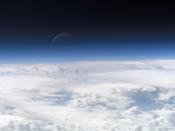The Earth is surrounded by a blanket of air, which we call the atmosphere. It reaches over 560 kilometers (348 miles) from the surface of the Earth, so we are only able to see what occurs fairly close to the ground. Life on Earth is supported by the atmosphere, solar energy, and our planet's magnetic fields. The atmosphere absorbs the energy from the Sun, recycles water and other chemicals, and works with the electrical and magnetic forces to provide a moderate climate. The atmosphere also protects us from high-energy radiation and the frigid vacuum of space.
Four distinct layers have been identified using thermal characteristics (temperature changes), chemical composition, movement, and density. These are:
The troposphere which starts at the Earth's surface and extends 8 to 14.5 kilometers high (5 to 9 miles). This part of the atmosphere is the densest. As you climb higher in this layer, the temperature drops from about 17 to -52 degrees Celsius. Almost all weather is in this region. The tropopause separates the troposphere from the next layer. The tropopause and the troposphere are known as the lower atmosphere.
The stratosphere starts just above the troposphere and extends to 50 kilometers (31 miles) high. Compared to the troposphere, this part of the atmosphere is dry and less dense. The temperature in this region increases gradually to -3 degrees Celsius, due to the absorption of ultraviolet radiation. The ozone layer, which absorbs and scatters the solar ultraviolet radiation, is in this layer. Ninety-nine percent of "air" is located in the troposphere and stratosphere. The stratopause separates the stratosphere from the next layer.
The mesosphere starts just above the stratosphere and extends to 85 kilometers (53 miles) high. In this region, the temperatures again fall as low as -93 degrees Celsius as you increase...



Well done
this is a good essay. you state the facts simperly and combine it with good explanation. however it would be good to see more infomation on the subject of the differnt layers. overall it was a good esay. well done :-)
4 out of 4 people found this comment useful.